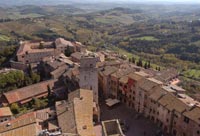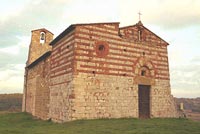The Val d’Elsa |
The Val d’Elsa lies between the provinces of Florence and Siena. Divided by the river Elsa, this area of Tuscany is one of the region’s most beautiful sections of countryside. As well as boasting a vast historical and artistic heritage made up of chapels, churches, ancient monuments and magnificent 15th and 16th century villas such as Collazzi and Tattoli, the Val d’Elsa also abounds in excellent restaurants and fine regional cuisine.
|
| The origins of La Suvera go back to the High Middle Ages as the Castle of the Country of Siena ruled by the legendary Countess Ava Matilde dè Franzesi, a relation of the King of France Clovis. It is therefore likely that the ancient name La Suvera derives from the French 'Souveraine', meaning Sovereign. La Suvera passed, in episodes of alternate good fortune and ill luck, to Pope Julius II. He entrusted La Suvera to the genius of Baldassarre Peruzzi, who blended the severity of the medieval fortress with the sumptuous luxury of the Renaissance to create the villa as we know it today. Relais La Suvera has 13 suites and 19 rooms all furnished with antiques and historical pieces belonging to the families of the owners, a rare collection made available to guests just as it would in a private home. Each suite has its inventory which guests may consult should they feel inclined to satisfy their curiosità and know more of the furnishings and furniture surrounding them. [read more] |
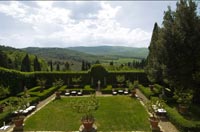 La Suvera, the formal Italian garden |
||
| Colle di Val d'Elsa | Colle di Val d'Elsa is spread over three levels descending gently downhill. The urban layout is divided into three "terzieri"; the modern area the Piano, the Borgo and the Castello which is the old town.
Piano |
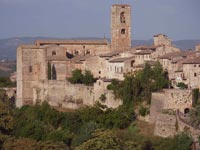 Colle di Vald'Elsa, Duomo |
|
| Abbazia di Conéo is a Romanesque structure that was founded by the Vallombrosan monks at the start of the 12 C and is one of the most interesting examples of religious architecture near Colle Val d'Elsa. Its plan is in the shape of the Latin cross, as is typical of Vallombrosan churches, and the intersection of the nave and the transept is surmounted by a sectioned dome, which is octagonal inside. The internal capitals and the cornice which runs round the outside of the building are decorated with starred flowers and other geometrical devices, of great artistic beauty. The building possesses a number of pre-Romanesque features, with numerous external brackets in the shape of imaginary animals . |
|||
The Romanesque Pieve of SS. Ippolito and Cassiano existed as far back as the 10 C and was later part of the bishopric of Volterra, while towards the end of the 12 C it came into the sphere of political influence of the municipality of Colle Val d'Elsa. The building as we see it today, , is the product of various renovations in the mediaeval period and work on it during the Romanesque period seems to have lasted for over 50 years: from the end of the 12 C until the middle of the 13 C.
|
|||
Barberino Val d'Elsa
|
|||
The Pieve of Barberino A winding hilly road, once the ancient Via Cassia and now State road n° 2, leads up to the town of Barberino Val d'Elsa, situated high up above the valley from which it takes its name and halfway between Florence and Siena, on the north-western borders of the Chianti area. Barberino Val d'Elsa is located in a dominating position on the ridge separating the watersheds of the Elsa and the Pesa rivers. The town has retained its mediaeval elliptical shape with a main street running between the two turreted tower gates, the Porta Romana and the Porta Fiorentina. The Chapel of San Michele Arcangelo is particularly interesting. Built in 1597 by Santi di Tito, it is a perfect 1:8 scale reproduction of the Cupola or Dome of the Cathedral of Florence. The archaeological site of Semifonte is located within Berberino's territory.
|
|||
| The Antiquarium of Sant’Appiano is a small archaeological museum located in rooms adjoining the Pieve di Sant’Appiano just a few km from Barberino Val d’Elsa. La Pieve di Sant’Appiano (The parish church of Sant'Appiano) The church itself, built in early Romanesque times with a nave and two aisles with apses |
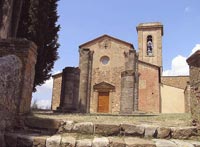 |
||
| VICO D'ELSA | |||
| SEMIFONTE | |||
| PONETA - PASTINE - POPPIANO | |||
| MARCIALLA | |||
| PETROGNANO | |||
| LINARI | |||
| SAN FILIPPO - PONZANO | |||
| SAN MARTINO AI COLLI | |||
| San Martino ai Colli is a group of very old houses built on either side of the Via Cassia road; many are farmhouses but some were originally built to offer various services to wayfarers, as well as pilgrims of course, on their way to Rome. The cemetery chapel now remains as the local place of worship. Chapel of San Martino ai Colli Situated inside the cemetery of San Martino, the chapel has taken on historical importance since the discovery of two Etruscan tombs dating from the 8th-7th centuries B.C. beneath its foundations. Necropolis of San Martino ai Colli The excavations of 1960 brought to light a necropolis with chamber tombs and funerary furnishings dating from the end of the 6th century. The large amount and variety of material brought to light leads us to believe that a small necropolis once stood here and that, over the centuries, tombs from various periods had ended up one on top of the other and in communication. |
|||

